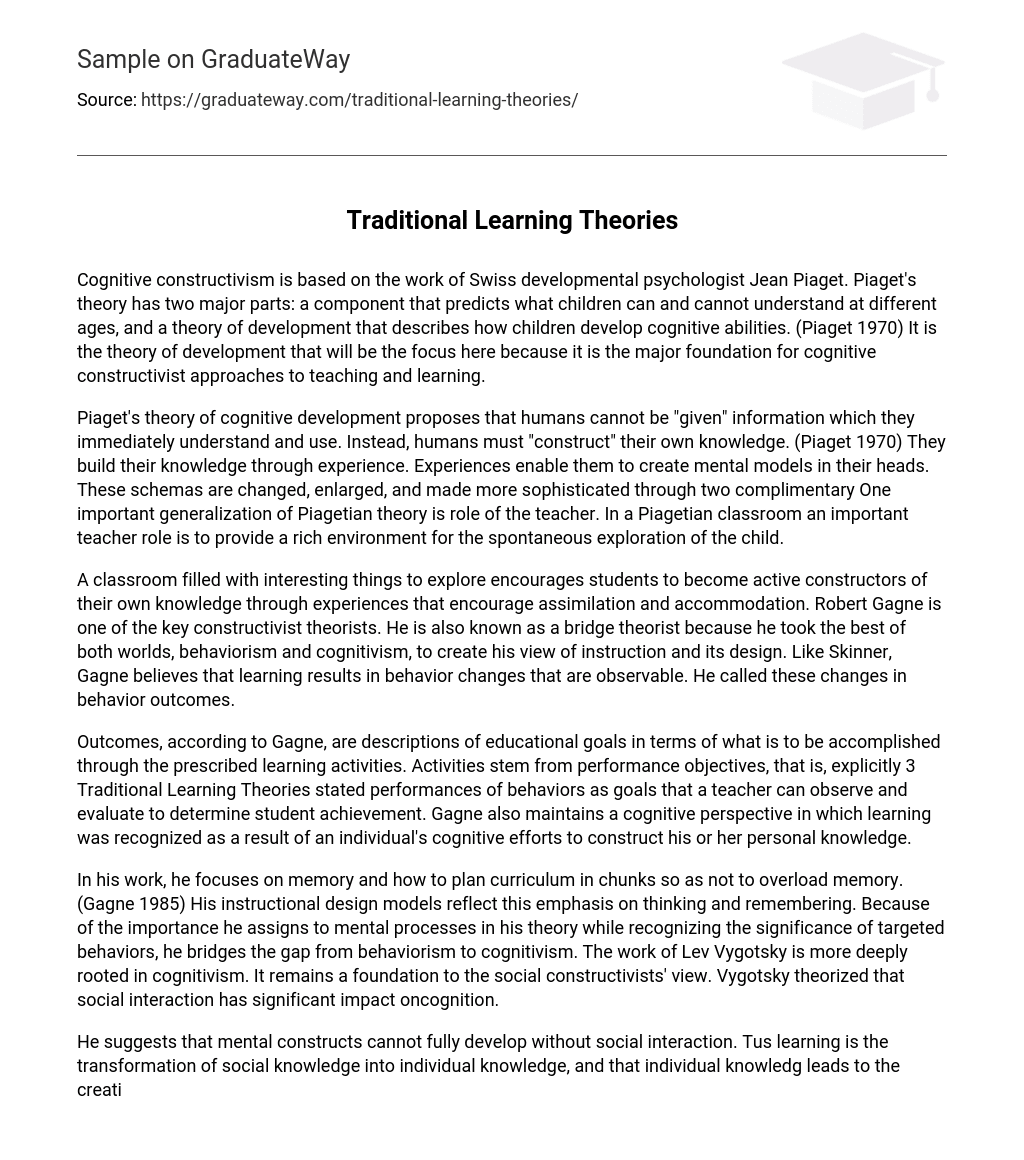Cognitive constructivism is based on the work of Swiss developmental psychologist Jean Piaget. Piaget’s theory has two major parts: a component that predicts what children can and cannot understand at different ages, and a theory of development that describes how children develop cognitive abilities. (Piaget 1970) It is the theory of development that will be the focus here because it is the major foundation for cognitive constructivist approaches to teaching and learning.
Piaget’s theory of cognitive development proposes that humans cannot be “given” information which they immediately understand and use. Instead, humans must “construct” their own knowledge. (Piaget 1970) They build their knowledge through experience. Experiences enable them to create mental models in their heads. These schemas are changed, enlarged, and made more sophisticated through two complimentary One important generalization of Piagetian theory is role of the teacher. In a Piagetian classroom an important teacher role is to provide a rich environment for the spontaneous exploration of the child.
A classroom filled with interesting things to explore encourages students to become active constructors of their own knowledge through experiences that encourage assimilation and accommodation. Robert Gagne is one of the key constructivist theorists. He is also known as a bridge theorist because he took the best of both worlds, behaviorism and cognitivism, to create his view of instruction and its design. Like Skinner, Gagne believes that learning results in behavior changes that are observable. He called these changes in behavior outcomes.
Outcomes, according to Gagne, are descriptions of educational goals in terms of what is to be accomplished through the prescribed learning activities. Activities stem from performance objectives, that is, explicitly 3 Traditional Learning Theories stated performances of behaviors as goals that a teacher can observe and evaluate to determine student achievement. Gagne also maintains a cognitive perspective in which learning was recognized as a result of an individual’s cognitive efforts to construct his or her personal knowledge.
In his work, he focuses on memory and how to plan curriculum in chunks so as not to overload memory. (Gagne 1985) His instructional design models reflect this emphasis on thinking and remembering. Because of the importance he assigns to mental processes in his theory while recognizing the significance of targeted behaviors, he bridges the gap from behaviorism to cognitivism. The work of Lev Vygotsky is more deeply rooted in cognitivism. It remains a foundation to the social constructivists’ view. Vygotsky theorized that social interaction has significant impact oncognition.
He suggests that mental constructs cannot fully develop without social interaction. Tus learning is the transformation of social knowledge into individual knowledge, and that individual knowledg leads to the creation of the mental constructs that embrace it, because knowlege tends to relate to the culture through which it is presented, Vygotsky suggested that educators ebrace the culture of the learner. Much of learning is acquired from family, peers, and teachers. Knowledge transmitted from these sources cannot help being tied to the social values of the community to which all belong. Gagne 1985) For Vygotsky, learning must therefore, at its most fundamental stage, be cooperative in nature. Vygotsky suggests that learning groups are critical components of the teaching and learning process and that teachers should move into the role of 4 Traditional Learning Theories guide and commentator. Furthermore, curriculum should emphasize social issues and language skills to ensure communication between and among learning group members. Complementing Vygotsky’s view is Albert Bandura’s social learning theory. In this theory, Bandura begins to integrate the various perspectives on learning.
Social learning theory suggests that behavior is the result of continuous interaction among cognition, behavior, and the environment. (Bandura 1976) This theory stresses the importance of observation and modeling; that is, imitating the behavior of others develops one’s own mental models. Bandura summed up his vision of education as follows: “It is evident from informal observation that human behavior is transmitted, whether deliberately or inadvertently, largely through exposure to social models. ” (Bandura 1976) Bandura suggested that learning is a socially interactive process.
Through modeling behaviors, conformity to social rules is attained. In this process, a learner is motivated to perform specific behaviors through outcome expectancies, that is, expectations of specific outcomes if a behavior is modeled correctly. (Bandura 1976) Thus a learner who observes a respected adult perform a behavior that results in praise and community approval will develop expectancies of praise and approval if he or she correctly emulates that model’s behavior. Learning, then, is a product of this type of social interaction on one’s cognitive processes.





